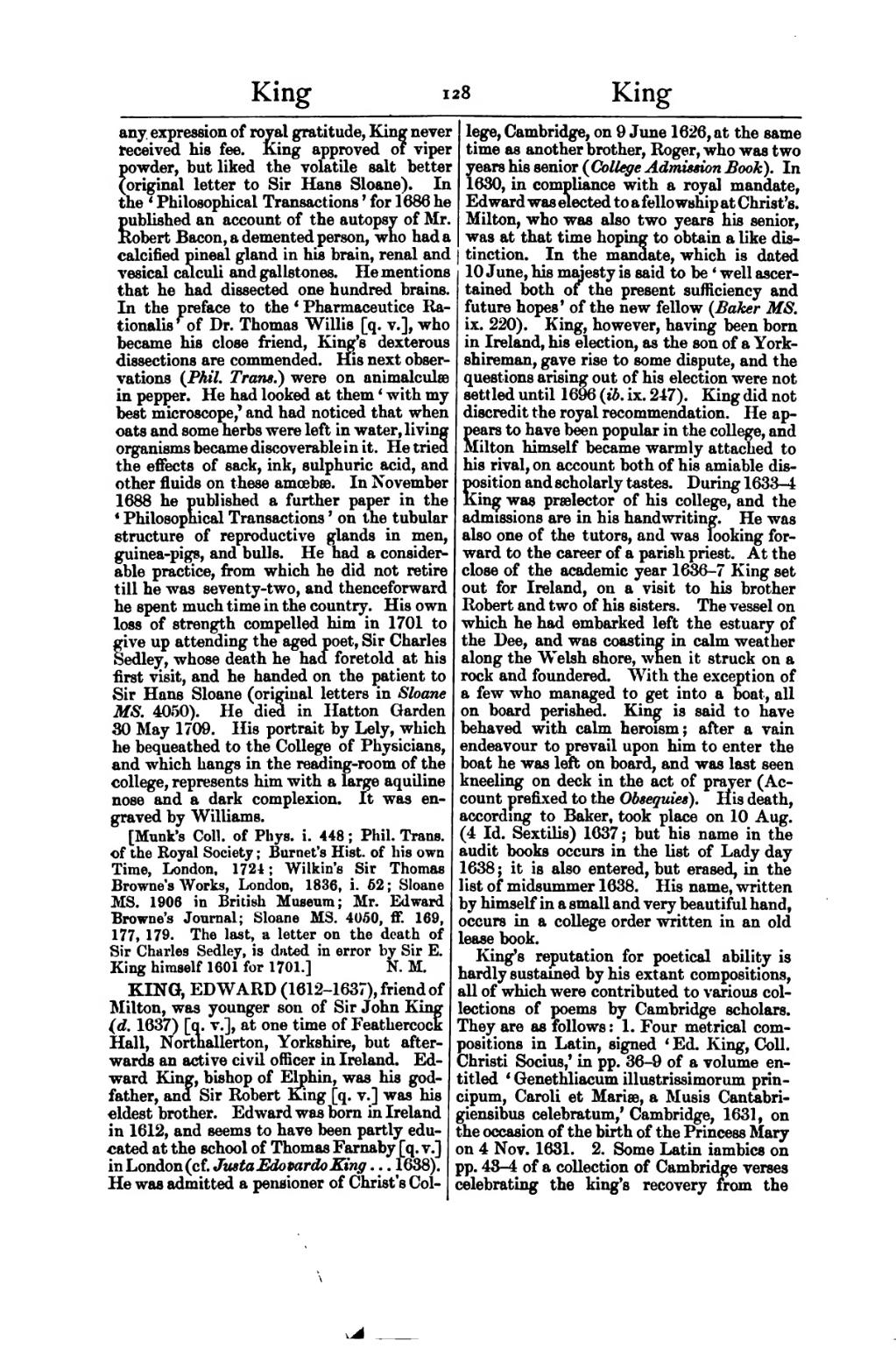any expression of royal gratitude, King never received his fee. King approved of viper powder, but liked the volatile salt better (original letter to Sir Hans Sloane). In the ‘Philosophical Transactions’ for 1686 he published an account of the autopsy of Mr. Robert Bacon, a demented person, who had a calcified pineal gland in his brain, renal and vesical calculi and gallstones. He mentions that he had dissected one hundred brains. In the preface to the ‘Pharmaceutice Rationalis’ of Dr. Thomas Willis [q. v.], who became his close friend, King's dexterous dissections are commended. His next observations (Phil. Trans.) were on animalculæ in pepper. He had looked at them ‘with my best microscope,’ and had noticed that when oats and some herbs were left in water, living organisms became discoverable in it. He tried the effects of sack, ink, sulphuric acid, and other fluids on these amœbæ. In November 1688 he published a further paper in the ‘Philosophical Transactions’ on the tubular structure of reproductive glands in men, guinea-pigs, and bulls. He had a considerable practice, from which he did not retire till he was seventy-two, and thenceforward he spent much time in the country. His own loss of strength compelled him in 1701 to give up attending the aged poet, Sir Charles Sedley, whose death he had foretold at his first visit, and he handed on the patient to Sir Hans Sloane (original letters in Sloane MS. 4050). He died in Hatton Garden 30 May 1709. His portrait by Lely, which he bequeathed to the College of Physicians, and which hangs in the reading-room of the college, represents him with a large aquiline nose and a dark complexion. It was engraved by Williams.
[Munk's Coll. of Phys. i. 448; Phil. Trans. of the Royal Society; Burnet's Hist. of his own Time, London, 1724; Wilkin's Sir Thomas Browne's Works, London, 1836, i. 52; Sloane MS. 1906 in British Museum; Mr. Edward Browne's Journal; Sloane MS. 4050, ff. 169, 177, 179. The last, a letter on the death of Sir Charles Sedley, is dated in error by Sir E. King himself 1601 for 1701.]
KING, EDWARD (1612–1637), friend of Milton, was younger son of Sir John King (d. 1637) [q. v.], at one time of Feathercock Hall, Northallerton, Yorkshire, but afterwards an active civil officer in Ireland. Edward King, bishop of Elphin, was his godfather, and Sir Robert King [q. v.] was his eldest brother. Edward was born in Ireland in 1612, and seems to have been partly educated at the school of Thomas Farnaby [q. v.] in London (cf. Justa Edovardo King … 1638). He was admitted a pensioner of Christ's College, Cambridge, on 9 June 1626, at the same time as another brother, Roger, who was two years his senior (College Admission Book). In 1630, in compliance with a royal mandate, Edward was elected to a fellowship at Christ's. Milton, who was also two years his senior, was at that time hoping to obtain a like distinction. In the mandate, which is dated 10 June, his majesty is said to be ‘well ascertained both of the present sufficiency and future hopes’ of the new fellow (Baker MS. ix. 220). King, however, having been born in Ireland, his election, as the son of a Yorkshireman, gave rise to some dispute, and the questions arising out of his election were not settled until 1696 (ib. ix. 247). King did not discredit the royal recommendation. He appears to have been popular in the college, and Milton himself became warmly attached to his rival, on account both of his amiable disposition and scholarly tastes. During 1633–4 King was prælector of his college, and the admissions are in his handwriting. He was also one of the tutors, and was looking forward to the career of a parish priest. At the close of the academic year 1636–7 King set out for Ireland, on a visit to his brother Robert and two of his sisters. The vessel on which he had embarked left the estuary of the Dee, and was coasting in calm weather along the Welsh shore, when it struck on a rock and foundered. With the exception of a few who managed to get into a boat, all on board perished. King is said to have behaved with calm heroism; after a vain endeavour to prevail upon him to enter the boat he was left on board, and was last seen kneeling on deck in the act of prayer (Account prefixed to the Obsequies). His death, according to Baker, took place on 10 Aug. (4 Id. Sextilis) 1637; but his name in the audit books occurs in the list of Lady day 1638; it is also entered, but erased, in the list of midsummer 1638. His name, written by himself in a small and very beautiful hand, occurs in a college order written in an old lease book.
King's reputation for poetical ability is hardly sustained by his extant compositions, all of which were contributed to various collections of poems by Cambridge scholars. They are as follows: 1. Four metrical compositions in Latin, signed ‘Ed. King, Coll. Christi Socius,’ in pp. 36–9 of a volume entitled ‘Genethliacum illustrissimorum principum, Caroli et Mariæ, a Musis Cantabrigiensibus celebratum,’ Cambridge, 1631, on the occasion of the birth of the Princess Mary on 4 Nov. 1631. 2. Some Latin iambics on pp. 43–4 of a collection of Cambridge verses celebrating the king's recovery from the
